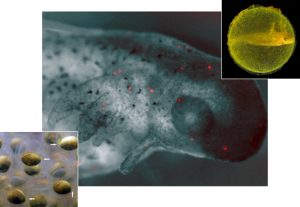It might sound like something out of a Dr. Seuss story, but biologists have long told tales of the green eggs of the spotted salamander. Ambystoma maculatum lays its brood in ponds each spring up and down North America. These marble-sized gelatinous sacs quickly turn green (bottom left and top right images) as photosynthesizing algae grow around the developing embryo and feast on its waste. In turn, the embryo enjoys the oxygen produced by the algae. Now scientists have discovered that the algae gets a little closer than they thought. Using long-exposure imaging, the researchers detected algal fluorescence (main image) inside the developing salamander. This is the first case of an algae living symbiotically within a vertebrate, the team reports online today in the Proceedings of National Academy of Sciences. How the photosynthesizing algae gets there, and how it survives inside the tissues and cells of this predominantly nocturnal amphibian is still baffling to scientists. But one thing’s for sure, the discovery means rewriting textbooks to add salamanders to a short list of organisms, including coral and bacteria, that form symbiotic relationships with plants.
:: Read original here ::
